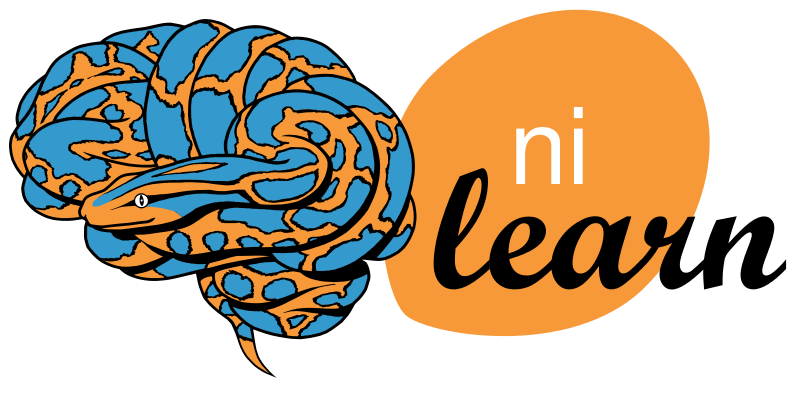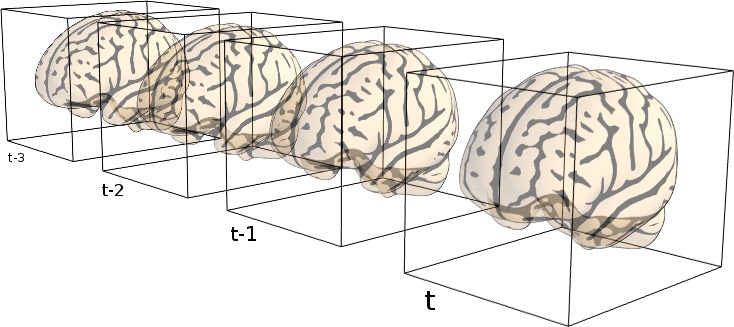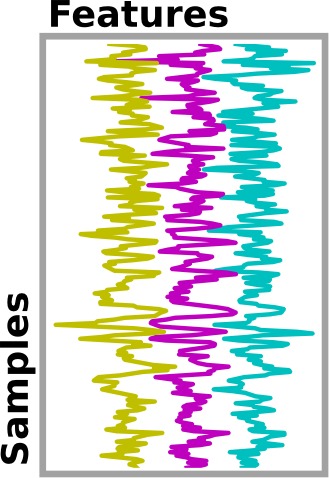4.2. Data preparation: loading and basic transformation¶
Contents
- The concept of “masker” objects
NiftiMasker: loading, masking and filtering- Extraction of signals from regions:
NiftiLabelsMasker,NiftiMapsMasker.
File names as arguments
For most functions or objects, it is not necessary to explicitely load the data. Indeed, most of nilearn functions can take file names as arguments:
>>> from nilearn import image
>>> smoothed_img = image.smooth_img('/home/user/t_map001.nii')
Nilearn can operate on either filenames, or NiftiImage objects, which are in-memory representation of the nifti files. We often use as a shorthand the term ‘niimg’ to denote either a filename or a NiftiImage object. In the example above, the function smooth_img returns a NiftiImage object, which can then be readily passed to any other nilearn function that accept niimg arguments.
4.2.1. The concept of “masker” objects¶
In any analysis, the first step is to load the data. Often, for statistical analysis, it is convenient to apply some basic transformations and to turn the data in a 2D (samples x features) matrix, where the samples could be different time points, and the features different voxels or different ROIs.
“masker” objects (found in modules nilearn.input_data) are there
to make these operations easy.
The philosophy underlying these classes is similar to scikit-learn‘s transformers. Objects are initialized with some parameters proper to the transformation (unrelated to the data), then the fit() method should be called, possibly specifying some data-related information (such as number of images to process), to perform some initial computation (e.g. fitting a mask based on the data). Then transform() can be called, with the data as argument, to perform some computation on data themselves (e.g. extracting timeseries from images).
Note that the masker objects may not cover all the image transformations
for specific tasks. Users who want to make some specific processing may
have to call low-level functions (see e.g. nilearn.signal,
nilearn.masking.)
4.2.2. NiftiMasker: loading, masking and filtering¶
This section describes how to use the NiftiMasker class in
more details than the previous description. NiftiMasker is a
powerful tool to load images and extract voxel signals in the area
defined by the mask. It is designed to apply some basic preprocessing
steps by default with commonly used default parameters. But it is
very important to look at your data to see the effects of the
preprocessings and validate them.
In addition, NiftiMasker is a scikit-learn compliant
transformer so that you can directly plug it into a scikit-learn
pipeline.
4.2.2.1. Custom data loading¶
Sometimes, some custom preprocessing of data is necessary. For instance
we can restrict a dataset to the first 100 frames. Below, we load
a resting-state dataset with fetch_fetch_nyu_rest(), restrict it to 100 frames and
build a brand new Nifti-like object to give it to the masker. Though it
is possible, there is no need to save your data in a file to pass it to a
NiftiMasker. Simply use nibabel to create a Niimg
in memory:
nyu_dataset = datasets.fetch_nyu_rest(n_subjects=1)
nyu_filename = nyu_dataset.func[0]
nyu_img = nibabel.load(nyu_filename)
# Restrict nyu to 100 frames to speed up computation
from nilearn.image import index_img
nyu_img = index_img(nyu_img, slice(0, 100))
4.2.2.2. Controlling how the mask is computed from the data¶
In the basic tutorial, we showed how the masker could compute a mask automatically, and it has done a good job. But, on some datasets, the default algorithm performs poorly. This is why it is very important to always look at how your data look like.
4.2.2.2.1. Computing the mask¶
Note
The full example described in this section can be found here:
plot_mask_computation.py.
This one can be relevant too:
plot_nifti_simple.py.
If a mask is not given, NiftiMasker will try to compute
one. It is very important to take a look at the generated mask, to see if it
is suitable for your data and adjust parameters if it is not. See the
NiftiMasker documentation for a complete list of mask computation
parameters.
As an example, we will now try to build a mask based on a dataset from scratch. The Haxby dataset will be used since it provides a mask that we can use as a reference.
The first step is to generate a mask with default parameters and take a look at it.
# We need to specify an 'epi' mask_strategy, as this is raw EPI data
masker = NiftiMasker(mask_strategy='epi')
masker.fit(nyu_img)
plot_roi(masker.mask_img_, nyu_mean_img, title='EPI automatic mask')
We can make the outline of the mask more by increasing the number of
opening steps (opening=10) using the mask_args argument of the
NiftiMasker.
masker = NiftiMasker(mask_strategy='epi', mask_args=dict(opening=10))
masker.fit(nyu_img)
plot_roi(masker.mask_img_, nyu_mean_img, title='EPI Mask with strong opening')
Looking at the nilearn.masking.compute_epi_mask called by the
NiftiMasker object, we see two interesting parameters:
lower_cutoff and upper_cutoff. These set the grey-values bounds in
which the masking algorithm is going to try to find it’s threshold (where
0 is the minimum of the image, and 1 the maximum). Here we raise a lot
the lower cutoff, and thus force the masking algorithm to select only
voxels that are very light on the EPI image.
masker = NiftiMasker(mask_strategy='epi',
mask_args=dict(upper_cutoff=.9, lower_cutoff=.8,
opening=False))
masker.fit(nyu_img)
plot_roi(masker.mask_img_, nyu_mean_img, title='EPI Mask: high lower_cutoff')
4.2.2.3. Common data preparation steps: resampling, smoothing, filtering¶
See also
If you don’t want to use the NiftiMasker to perform these
simple operations on data, note that they are
corresponding functions.
4.2.2.3.1. Resampling¶
NiftiMaskerand many similar classes enable resampling images.- The resampling procedure takes as input the target_affine to resample (resize, rotate...) images in order to match the spatial configuration defined by the new affine. Additionally, a target_shape can be used to resize images (i.e. croping or padding with zeros) to match an expected shape.
Resampling can be used for example to reduce processing time by lowering image resolution. Certain image viewers also require images to be resampled to display overlays.
Automatic computation of offset and bounding box can be performed by specifying a 3x3 matrix instead of the 4x4 affine, in which case nilearn computes automatically the translation part of the affine.



Special case: resampling to a given voxel size
Specifying a 3x3 matrix that is diagonal as a target_affine fixes the voxel size. For instance to resample to 3x3x3 mm voxels:
>>> import numpy as np
>>> target_affine = np.diag((3, 3, 3))
See also
4.2.2.3.2. Smoothing¶
If smoothing the data prior to converting to voxel signals is required, it can
be performed by NiftiMasker. It is achieved by passing the full-width
half maximum (in millimeter) along each axis in the parameter smoothing_fwhm.
For an isotropic filtering, passing a scalar is also possible. The underlying
function handles properly the tricky case of non-cubic voxels, by scaling the
given widths appropriately.
See also
4.2.2.3.3. Temporal Filtering¶
All previous filters operate on images, before conversion to voxel signals.
NiftiMasker can also process voxel signals. Here are the possibilities:
- Confound removal. Two ways of removing confounds are provided. Any linear
trend can be removed by activating the detrend option. It is not activated
by default in
NiftiMaskerbut is almost essential. More complex confounds can be removed by passing them toNiftiMasker.transform. If the dataset provides a confounds file, just pass its path to the masker. - Linear filtering. Low-pass and high-pass filters can be used to remove artifacts. Care has been taken to apply this processing to confounds if necessary.
- Normalization. Signals can be normalized (scaled to unit variance) before returning them. This is performed by default.
Exercise
You can, more as a training than as an exercise, try to play with the parameters in Simple example of decoding: the Haxby data. Try to enable detrending and run the script: does it have a big impact on the result?
See also
4.2.2.4. Inverse transform: unmasking data¶
Once voxel signals have been processed, the result can be visualized as images after unmasking (turning voxel signals into a series of images, using the same mask as for masking). This step is present in almost all the examples provided in nilearn. Below is an excerpt of the example performing Anova-SVM on the Haxby data):
coef = svc.coef_
# reverse feature selection
coef = feature_selection.inverse_transform(coef)
# reverse masking
weight_img = nifti_masker.inverse_transform(coef)
4.2.3. Extraction of signals from regions: NiftiLabelsMasker, NiftiMapsMasker.¶
The purpose of NiftiLabelsMasker and NiftiMapsMasker is to
compute signals from regions containing many voxels. They make it easy to get
these signals once you have an atlas or a parcellation.
4.2.3.1. Regions definition¶
Nilearn understands two different ways of defining regions, which are called
labels and maps, handled respectively by NiftiLabelsMasker and
NiftiMapsMasker.
- labels: a single region is defined as the set of all the voxels that have a common label (usually an integer) in the region definition array. The set of regions is defined by a single 3D array, containing at each location the label of the region the voxel is in. This technique has one big advantage: the amount of memory required is independent of the number of regions, allowing for representing a large number of regions. On the other hand, there are several contraints: regions cannot overlap, and only their support could be represented (no weighting).
- maps: a single region is defined as the set of all the voxels that have a non-zero weight. A set of regions is thus defined by a set of 3D images (or a single 4D image), one 3D image per region. Overlapping regions with weights can be represented, but with a storage cost that scales linearly with the number of regions. Handling a large number (thousands) of regions will prove difficult with this representation.
Note
These usage are illustrated in Extracting times series to build a functional connectome
4.2.3.2. NiftiMapsMasker Usage¶
This atlas defines its regions using maps. The path to the corresponding file is given in the “maps_img” argument. Extracting region signals for several subjects can be performed like this:
One important thing that happens transparently during the execution of
NiftiMasker.fit_transform is resampling. Initially, the images
and the atlas do not have the same shape nor the same affine. Getting
them to the same format is required for the signals extraction to
work. The keyword argument resampling_target specifies which format
everything should be resampled to.
See the reference documentation for NiftiMapsMasker for every
possible option.
4.2.3.3. NiftiLabelsMasker Usage¶
Usage of NiftiLabelsMasker is similar to that of
NiftiMapsMasker. The main difference is that it requires a labels image
instead of a set of maps as input.
The background_label keyword of NiftiLabelsMasker deserves
some explanation. The voxels that correspond to the brain or a region
of interest in an fMRI image do not fill the entire
image. Consequently, in the labels image, there must be a label
corresponding to “outside” the brain, for which no signal should be
extracted. By default, this label is set to zero in nilearn, and is
referred to as “background”. Should some non-zero value occur, it is
possible to change the background value with the background_label
keyword.





